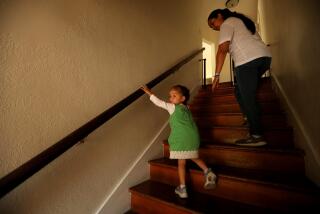The driving factor
- Share via
It may have been its Mission architecture that inspired Jim Grace and Cameron Kelley to buy their new home in Los Angeles’ Koreatown, but slashing their travel time to work made them fall in love with the place.
Grace no longer has a grueling 70-minute commute from Toluca Lake to the South Bay that routinely stalled at the transition of the Ventura and San Diego freeways. Nowadays, he hops on the Harbor Freeway shortly after 7 a.m. and arrives at his job at a home-video company 20 minutes later. Kelley, an attorney, can bicycle the few miles to his office in the Transamerica Building downtown.
Kelley and Grace are among the homeowners for whom travel time to work has become a key factor in deciding where to live because of increasingly stressful commutes, the high cost of car ownership and the desire to spend more “quality time” with family. These factors are convincing some home buyers to forgo the slow crawl of commuting from distant suburbs and seek housing close to work -- often in dense, urban environments.
“I cannot stress how liberating it is to go from an hour and 10 minutes to 19 minutes,” said Grace, who now is often the first in the office and has time to make coffee.
Choosing a house based on commuting arguably marks the most dramatic shift in home-buying attitudes among Southern Californians since the post-World War II march to the suburbs began. Less than a generation ago, few home buyers would have had second thoughts about buying a new tract house in the suburbs and driving long distances to work.
Los Angeles has been the nation’s No. 1 congested urban area since 1987. Area residents with an average 30-minute commute time in 2001 wasted about 108 hours, or more than four days, on extra travel time because of delays, according to Tim Lomax, co-author of the 2003 Urban Mobility Report released last week by the Texas Transportation Institute.
Another study showed that as much as 20% of a household’s income is spent on transportation -- the second-highest expense after housing for many families.
Although tracking a clear relationship between commuting times and home-buying choices is difficult, housing experts say they see an emerging pattern.
“People will pay a lot for housing in Santa Monica and West Hollywood or Brentwood, more than those same houses would be worth further out in the suburbs, because those places are close to major employment centers,” said Elizabeth Deakin, director of the Transportation Research Center at UC Berkeley.
Cases in point are the growing popularity of “in-town” neighborhoods, including Hancock Park, Larchmont, Echo Park, Silver Lake and West Adams. Even some “transitional” neighborhoods, such as parts of West Adams, where houses were historically slow to sell, are attracting multiple offers, according to John Aaroe, president of Prudential California Realty, John Aaroe Division, a Los Angeles-based residential real estate brokerage.
“Buying homes close to work is a trend across the board,” he said, “from first-time buyers to trade-up buyers.”
The phenomenon is something that has caught on in Los Angeles only in the last couple of years, although people in San Diego and San Jose have been doing it for a while, said Julie Bornstein, director of the Keston Infrastructure Institute at the USC Lusk Center for Real Estate. Buying closer to work may have caught on faster in San Diego and San Jose, she said, because drivers are largely dependent on single freeways -- Interstate 5 in San Diego and the 101 Freeway in Silicon Valley.
Sherri and Stephen Moss, longtime renters in Culver City, considered commuting times when they shopped for homes with their 6- and 8-year-old daughters last year in suburban locations from Riverside County to Encino Park. A family outing from Culver City to a prospective home in Encino took more than an hour, recalled Stephen Moss, art director for a publishing company in Culver City. “We all looked at each other and said, ‘No way.’ ”
Rather than buy a three-bedroom, two-bath house in the Encino area in the high $280,000 range, the Mosses chose instead to buy a two-bedroom, two-bath condominium in Culver City for about $60,000 less. The commute is, of course, far shorter than the Encino option for Stephen Moss as well as for his wife, who works as a freight-company clerk in the LAX area.
Commuting time can be a quality-of-life issue for the whole family. Actress Wendy Lawless and her husband, screenwriter David Kidd, toured suburban communities, including La Canada Flintridge, Malibu, Mount Washington and Rancho Palos Verdes, before settling on the West Adams area to shop for a vintage Craftsman home.
“It would not be good for David to sit for hours on the freeway and get his blood pressure up,” said Lawless, adding that a frazzled dad “would not be good for the family either.”
For some, living close to work is a matter of saving money as well as time. Even before gasoline prices climbed past $2 a gallon, the household cost of owning and operating a car was second only to housing, according to a report released in July by the Surface Transportation Policy Project.
The average American household spent about 19.3%, or $7,633 of its income on transportation, including car payments, insurance, gasoline and repairs, in 2001. Residents in Los Angeles, Orange, Riverside, San Bernardino and Ventura counties spent 17.9%, or $8,104 per household. The cost of commuting by car, in fact, can chip away at a household’s ability to afford a home.
“As families spend more on getting around, they have less available to save for a down payment on a house,” the report concluded, adding that for low-income families those costs can “destroy their chances for mortgage approval.”
Car expenses can even stall home buying for some like Kim Walters, an associate in a Westside advertising agency. Last May, Walters found she would need to reduce her monthly car payments by $250 to qualify for a $150,000 home. A job promotion has since brought in more income, and Walters now qualifies for a $250,000 home. She must still lower her car payments, however, so that her combined housing and transportation costs equal less than 36% of her total income. She probably will wait until her car is paid off next summer before buying a home.
Buyer Pat Cici Jr. solved the problem of lowering his monthly $350 car debt by paying off his auto lease early. He thereby reduced his combined housing and transportation costs so that he could qualify for a loan a year ago to buy a townhome in Whittier.
But living close to work may not dramatically cut transportation costs unless home buyers opt to use public transit. Lawless and Kidd, Kelley and Grace and the Mosses all remain two-car households.
Grace, who lived without a car for six years in San Francisco and for four years in Bangkok, said he would give up one car here except that public transportation is inadequate for their needs.
In their new home, he and Kelley spend less time on the road, in part because they are closer both to friends and entertainment in downtown Los Angeles.
“We used to have to leave at least 35 minutes before arriving anywhere,” he added. “Now we can leave 10 minutes before.”
Shorter driving times have their downside too, Grace said. When he commuted from his former home in Toluca Lake, he took a book with him to read when his car became immobilized in the daily gridlock.
Now, with a shorter commute, he said, almost sadly, “I’ve lost my reading time.”
*
(BEGIN TEXT OF INFOBOX)
Bumper to bumper from year to year
Annual hours of delay per person on all travel during peak hours of 6 to 9 a.m. and 4 to 7 p.m.
*--* 1982 1987 1990 1994 1998 2001 Los Angeles area* 19 39 53 46 56 52 San Francisco 12 35 37 24 32 42 San Jose 10 32 43 24 26 34 San Bernardino and Riverside 4 11 20 20 29 34 San Diego 3 9 16 14 16 25
*--*
*Includes Orange and Ventura counties.
Note: Delays eased during recessionary periods due to a combination of road improvements and slower traffic growth.
Source: Texas Transportation Institute’s 2003 Urban Mobility Study
*
(BEGIN TEXT OF INFOBOX)
The cost of commuting
Household spending on transportation, by metropolitan area, during 2000-2001:
*--* Transportation Transportation as a % expenditures of total expenditures San Diego $9,161 20.8% Houston $9,566 20.1% Los Angeles* $8,104 17.9% Atlanta $6,577 17.3% San Francisco/San Jose** $9,492 16.9% New York $7,295 15.1% United States $7,633 19.3%
*--*
*Includes Los Angeles, Orange, Riverside, San Bernardino and Ventura counties.
**Includes Alameda, Santa Clara and Santa Cruz counties.
Source: Surface Transportation Policy Project analysis of Bureau of Labor Statistics data
Morris Newman can be reached at Morris_Newman@sbcglobal .net
More to Read
Sign up for Essential California
The most important California stories and recommendations in your inbox every morning.
You may occasionally receive promotional content from the Los Angeles Times.






